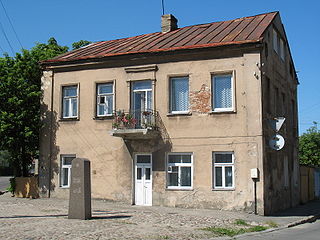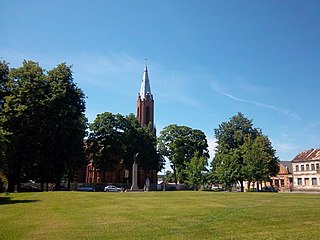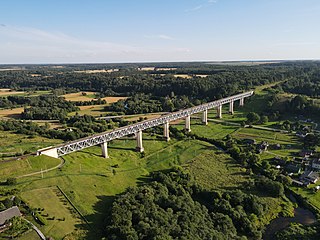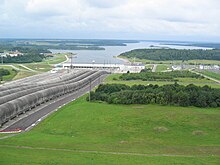
Kaunas is the second-largest city in Lithuania after Vilnius and an important centre of Lithuanian economic, academic, and cultural life. Kaunas was the largest city and the centre of a county in the Duchy of Trakai of the Grand Duchy of Lithuania and Trakai Palatinate since 1413. In the Russian Empire, it was the capital of the Kaunas Governorate from 1843 to 1915.

Międzyrzec Podlaski is a city in Biała Podlaska County, Lublin Voivodeship, Poland, with the population of 17,162 inhabitants as of 2006. The total area of the city is 20.03 square kilometres (7.73 sq mi). Międzyrzec is located near the Krzna river, not far from the border with Belarus.

Lutsk is a city on the Styr River in northwestern Ukraine. It is the administrative center of the Volyn Oblast (province) and the administrative center of the surrounding Lutsk Raion (district) within the oblast. Lutsk has a population of 215,986

Plungė is a city in Lithuania with 17,252 inhabitants. Plungė is known for Plungė Manor and its park, Samogitian Art Museum. In the Oginskiai manor park stands the Perkūnas oak a natural monument. The Lourdes of Plungė was created in 1905 and attracts visitors to this day. In the center of Plungė stands a monument for the 10th anniversary of regaining the independence of Lithuania and a sculpture of Saint Florian built by the Lithuanian book carrier Kazys Barzdys.

Kruonis Pumped Storage Plant is located near Kruonis, Lithuania, 34 km (21 mi) east of Kaunas. Its main purpose is to provide grid energy storage. It operates in conjunction with the Kaunas Hydroelectric Power Plant. During periods of low demand, usually at night, Kruonis PSHP raises water from the lower Kaunas reservoir to the upper one using cheap surplus energy. The station is designed to have an installed capacity of 1,600 MW but only four 225 MW generators are currently operational. With a fully filled upper reservoir the plant can generate 900 MW for about 12 hours.

Merkinė is a town in the Dzūkija National Park in Lithuania, located at the confluence of the Merkys, Stangė, and Nemunas rivers. Merkinė is one of the oldest settlements in Lithuania. The first settlers inhabited the confluence of Merkys and Nemunas in the 9th-10th century BC, at the end of the Paleolithic. On top of Merkinė hill-fort stood one of the most important Lithuanian castles, built in the 13th century, which guarded against invasions of the Teutonic Order. Merkinė was a part of a strategic triangle - Kaunas - Vilnius - Merkinė, protected with the chains of hillforts and castles. The center of Merkinė town is a state-protected urbanistic monument. Merkinė is an important point of Lithuania's domestic tourism.

Rokiškis is a city in northeastern Lithuania with a population of about 14,400.

Rietavas is a city in Lithuania on the Jūra River. According to the 2001 census it had a population of 3,979. It is the capital of Rietavas municipality.

The Kovno Ghetto was a ghetto established by Nazi Germany to hold the Lithuanian Jews of Kaunas during the Holocaust. At its peak, the ghetto held 29,000 people, most of whom were later sent to concentration and extermination camps, or were shot at the Ninth Fort. About 500 Jews escaped from work details and directly from the ghetto, and joined Soviet partisan forces in the distant forests of southeast Lithuania and Belarus.

Vepriai is the largest town in Ukmergė district, Lithuania, situated south-west of Ukmergė with population of about 549 (2011). The capital of Vepriai elderate.

The history of the Jews during World War II is almost synonymous with the persecution and murder of Jews which was committed on an unprecedented scale in Europe and European North Africa. The massive scale of the Holocaust which happened during World War II greatly affected the Jewish people and world public opinion, which only understood the dimensions of the Final Solution after the war. The genocide, known as HaShoah in Hebrew, aimed at the elimination of the Jewish people on the European continent. It was a broadly organized operation led by Nazi Germany, in which approximately six million Jews were murdered methodically and with horrifying cruelty. Although the Holocaust was organized by the highest levels of the Nazi German government, the vast majority of Jews murdered were not German, but were instead residents of countries invaded by the Nazis after 1938. Of the approximately 6 million Jews murdered by the Nazis, approximately 160,000 to 180,000 were German Jews. During the Holocaust in occupied Poland, more than one million Jews were murdered in gas chambers of the Auschwitz concentration camp alone. The murder of the Jews of Europe affected Jewish communities in Albania, Austria, Belarus, Belgium, Bosnia & Herzegovina, Channel Islands, Croatia, Czech Republic, Estonia, France, Germany, Greece, Hungary, Italy, Latvia, Libya, Lithuania, Luxembourg, Moldova, the Netherlands, North Macedonia, Norway, Poland, Romania, Russia, Serbia, Slovakia, and Ukraine.

Vievis is a small city in Elektrėnai municipality, Lithuania. It is located 14 km east of Elektrėnai, on Lake Vievis.

Žiežmariai is a city in the Kaišiadorys district municipality, Lithuania. It is located 6 km (3.7 mi) south of Kaišiadorys. The center of Žiežmariai is a state-protected urbanistic monument.

Šeduva is a city in the Radviliškis district municipality, Lithuania. It is located 18 km (11 mi) east of Radviliškis.

Veisiejai is a town in the Lazdijai district municipality, Lithuania. It is located 18 km (11 mi) south-east of Lazdijai. The Esperanto language was created in Veisiejai where L. L. Zamenhof started his practice as an ophthalmologist in 1885. There is a church dedicated to St. George, an old estate with a park, high school, kindergarten "Ąžuoliukas", a post office, a museum and monuments dedicated to the composer J. Neimontas and L. L. Zamenhof.
The Lithuanian TDA Battalions or TDA, were paramilitary units organized in June–August 1941 by the Provisional Government of Lithuania at the onset of Operation Barbarossa. Members of the TDA were known by many names such as Lithuanian auxiliaries, policemen, white-armbands, nationalists, rebels, partisans, or resistance fighters. TDA was intended as basis for the future independent Lithuanian Army, but soon it was taken over by Nazi officials and reorganized into the Lithuanian Auxiliary Police Battalions. The original TDA eventually became the 12th and the 13th Police Battalions. These two units took an active role in mass killings of the Jews in Lithuania and Belarus. Based on the Jäger Report, members of TDA murdered about 26,000 Jews between July and December 1941.

Ivyanets, also known as Ivianec, is a town in the Valozhyn District of Minsk Region, Belarus. It is located 56 kilometers (35 mi) west of Minsk, and has a population of 4,206 (2017).

Lyduvėnai is a small town in the Šiluva Eldership, Raseiniai District Municipality, Kaunas County in central Lithuania. The town is 15 km north of Raseiniai and is near the confluence of the Dubysa and Dratvuo rivers. Lyduvėnai is the home of the longest and highest railway bridge in Lithuania, the Lyduvėnai Bridge. The town possesses the eldership's center, has a railway stop, a school, a library, in addition to post. The town's postal code is LT-60046. Lyduvėnai is situated in the Dubysa regional park and has its information center in the town's school. The railway line Šiauliai–Tilžė and the highways to Raseiniai and Šiluva pass through Lyduvėnai. Lyduvėnai is in the Dubysa valley, in contrast to other towns in the Dubysa basin.

Vandžiogala is a small town in Kaunas County, Kaunas district municipality in central Lithuania. It is located 20 km (12 mi) north of Kaunas city municipality next to Urka brook. A Holy Trinity church was built in Vandžiogala in 1830.

Pumpėnai is a small town in Panevėžys County, in northeastern Lithuania. According to the 2011 census, the town has a population of 855 people.


























